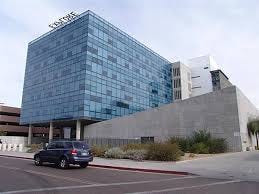Maybe I’m just sentimental, but I appreciate the architecture of Old Tempe. The original buildings at ASU had a consistent and appealing theme. My own campus, West Valley, is especially beautiful; it is often compared to a small liberal arts college. Its design features are reminiscent of the University of Virginia as envisioned by Thomas Jefferson, with large trees (considerable for the desert) and green lawns. ASU Polytechnic embraced the desert aesthetic with buildings that have an iron and cement look—it’s acceptable but not remarkable. However, the campus creates an inviting desert atmosphere. ASU Downtown, on the other hand, is nestled among the modest high-rises of Phoenix, offering the vibrant energy of a city experience.
Tempe is the original campus, but unfortunately, it has suffered from the effects of rapid growth. This growth did not preserve the original architectural designs. Unlike the University of Colorado at Boulder, which constructed all its buildings using local sandstone to create a unified and cohesive feel, ASU Tempe is a patchwork, a Frankenstein of mismatched styles. It is pieced together without any unity or common theme, conveying a lack of vision and conflicting elements that fail to come together as a coherent whole.
The ugliest building on campus is the Lattie Coor building, named after Dr. Coor, who served as president before Michael Crow. When Dr. Coor retired, the building was named in his honor. There is some speculation that its unfinished appearance stems from no current president wanting to spend money on a building dedicated to their predecessor. I disagree. I believe its design is intentional and serves as a fitting representation of the emptiness prevalent in modern humanities classes.
It is a typical rectangular building. Inside, the walls and floors are cement, with no carpeting. Exposed pipes holding wires are visible throughout. The offices are designed to be easily interchangeable, not integrated into the building itself; they can be remodeled or completely removed at any time. Nothing about it feels permanent. The entire structure seems unfinished.
Outside, the word "explore" hangs down from the roof, creating a reflection in the glass. If you know about occult imagery, this backward “explore” has a hidden purpose. The glass itself is etched with indecipherable figures, resembling letters but not forming any recognizable language for ASU students. Because of this, we’ve come to call it “The Tower of Babel.” Are they really just meaningless? Or is their meaning known to a few initiates into the secret?
Inside, you'll find the School of History, Philosophy, and Religious Studies. The building seems fitting for the subjects taught at ASU, reflecting a lack of unity and an inability to offer anything truly substantial or enduring. It often follows the latest intellectual trends, currently focused on issues like cultural appropriation and heteronormativity. These trends change roughly every decade, leaving nothing lasting in their wake. The building and its content are replaceable and forgettable, emphasizing temporary and superficial ideas.
The archtecthral atmosphere of Tempe lost its Old Tempe charm 20+ years ago+. Now it is at best pragmatic and utilitarian. A place to get the job done and get out as fast as you can. It tells you noting about beauty, or the sublime, or the summon bonum. However, this is merely truth in advertising. If the architecture of the campus did tell you those things you would fee lied to after taking an ASU humanities class in the Tower of Babel.




As a 1969 graduate, I always thought the Tempe campus was a hodgepodge, lacking any real identity. The ugliest building at the time was the Language and Literature building which we nicknamed Fort Lang. Actually, it looked more like a Southern Pacific warehouse.